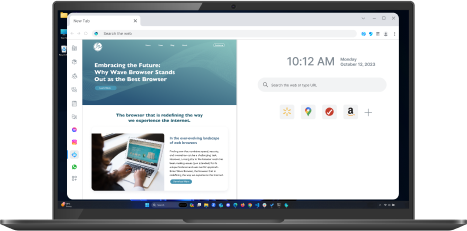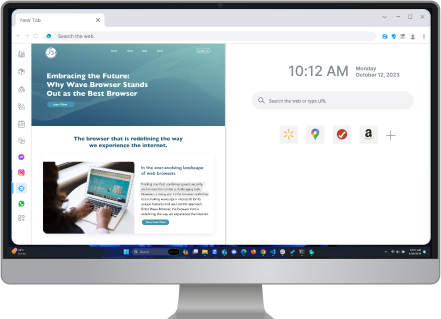8 Tips for Safe Browsing and Enhanced Online Security
Table of Contents

Staying safe while browsing the web is essential to protecting your personal information from cyber threats like phishing, malware, and data breaches. In this guide, we’ll share 8 essential tips for safe browsing that will help you avoid online risks and ensure a secure browsing experience.
Whether you're a casual surfer or a frequent online shopper, these simple yet effective tips will keep your data and privacy safe.
How Can I Protect Myself Online?
Protecting your personal information online is essential to avoid cyber threats like phishing, identity theft, and malware. Taking simple, proactive steps can significantly enhance your security while browsing the web. From using strong passwords to enabling two-factor authentication, there are several effective ways to keep your online activities safe.
This guide will provide you with key security measures to ensure your privacy remains protected:
Safe Browsing Practice 1: Use a Safe Browser and Keep Software Up to Date

A key element of safe browsing is using a trusted browser, like Wave Browser, and ensuring all your software—such as your operating system, web browsers, mobile devices, and security applications—are regularly updated.
Software updates include updates for:
- Operating Systems: Updates for your computer or mobile device's OS (e.g., Windows, macOS, Android, iOS) to fix security vulnerabilities and improve performance.
- Cybersecurity tools: Updates for antivirus, anti-malware, and firewall programs to protect against new threats and vulnerabilities.
- Plugins and Extensions: Updates for browser plugins and extensions, which are important for maintaining security and functionality.
If you receive a notification for an update, don’t ignore it!
Take the time to install it as soon as you can to ensure that you’re keeping yourself protected while browsing online. So don’t ignore those software update notifications, and take the time to update them!
Safe Browsing Practice 2: Utilize Strong and Unique Passwords

When it comes to safe browsing practices, one of the simplest and most effective steps you can take is to use strong and unique passwords. It is imperative to use strong, unique passwords for each account you create, yes even on innocuous sites like your Microsoft Teams account. Avoid using easily guessable information such as your name, birthdate, or common phrases.
Use complex passwords consisting of a combination of uppercase and lowercase letters, numbers, and special characters, and at least 12 characters long. Make sure to use a unique password for each account you have — this way, if one password is compromised, your other accounts will still be secure. Don’t forget to update your passwords regularly too!
By following these simple tips, you can help protect yourself and your sensitive information online. You might also consider using a reputable password manager, like LastPass or 1Password, to generate and store your passwords securely.
Safe Browsing Practice 3: Enable Two-Factor Authentication (2FA)

Two-factor authentication adds an extra layer of security to your online accounts by requiring additional verification beyond a password. Enable 2FA whenever possible as it is a simple yet effective way to enhance your online security.
With 2FA, you will need to provide an additional piece of information, such as a code sent to your phone or email, in addition to your password when logging into an account. This adds an extra layer of protection against hackers and cybercriminals who may try to gain access to your accounts. Many popular websites and apps offer 2FA as an option, so be sure to check your security settings and enable it wherever possible.
By taking this small step, you can help keep your personal information safe and secure while browsing online.
Safe Browsing Practice 4: Exercise Caution with Email and Attachments

We’ve all received suspicious emails with attachments that we’re not quite sure about. While it can be tempting to click on that link or open that file, it’s important to exercise caution when it comes to email and attachments.
Hackers and scammers often use email as a way to gain access to your personal information or infect your computer with malware. So, if you receive an email from an unknown sender or with an attachment that you weren’t expecting, take a moment to think before clicking.
Look for red flags like typos in the email or suspicious file names, and consider running a virus scan on any attachments before opening them. Avoid clicking on links or downloading attachments from unverified sources. Even if an email appears to be from a legitimate organization, double-check the sender’s address and verify the authenticity of the content before taking any action.
By being vigilant and cautious, you can help protect yourself from falling victim to these scams.
Safe Browsing Practice 5: Be Wary of Suspicious Websites

When browsing the internet, exercise caution and be mindful of the websites you visit. These sites can often contain spyware, malware, or other harmful content that can put your desktop computer and personal information at risk. Stick to reputable and well-known websites and avoid clicking on any suspicious links or pop-ups, especially when providing personal or financial information.
Look out for warning signs such as misspelled website names or URLs that don’t match the content of the site. Additionally, make sure to keep your antivirus software up-to-date and run regular scans to ensure that your computer is protected against any potential threats. By staying vigilant and practicing safe browsing habits, you can help protect yourself from online dangers.
Always look for the padlock symbol in the address bar and “https” in the URL to ensure you are using a secure connection.
Safe Browsing Practice 6: Employ Ad-Blocking and Anti-Malware Software

Ad-blocking and anti-malware software can be great tools for safe browsing. These firewall programs block pop-ups and can prevent potentially malicious ads from popping up on your screen and infecting your computer with viruses or malware. They can also help to protect your privacy by blocking annoying pop-ups and preventing advertisers from tracking your online activity.
Some popular ad-blocking and anti-malware programs include AdGone, uBlock Origin, and Ad Block. You might also try a browser that provides secure web browsing with a built-in ad-blocker, like Wave Browser. Installing one of these programs on your browser can help you browse the web safely and securely. So if you’re looking for a way to keep your computer safe while browsing the internet, consider giving ad-blocking and anti-malware software a try.
Safe Browsing Practice 7: Educate Yourself about Phishing and Scams

Cybercriminals are constantly evolving their tactics to deceive unsuspecting individuals. These types of online attacks can put your personal and financial information at risk, so it’s important to know how to spot them and avoid falling victim.
How to protect yourself from phishing and scams:
- Be skeptical of unsolicited requests for personal information, such as passwords, credit card details, or social security numbers.
- Remember that reputable organizations will never ask for sensitive information through email or unsolicited phone calls.
- Keep your software and antivirus up-to-date, and use strong passwords.
By staying informed and taking precautions, you can help ensure safe browsing and protect yourself from cyber threats. So go ahead, and browse with confidence! And if you ever have any doubts, directly contact the organization in question through verified channels to check on the legitimacy of any requests. CISSP certified professionals can also provide valuable guidance on best practices for maintaining your cybersecurity
Safe Browsing Practice 8: Use a Virtual Private Network or VPN

Using a VPN is a great way to practice safe browsing while protecting your online privacy and cybersecurity. A VPN, or virtual private network, creates a secure and encrypted connection between your device and the internet, which means that all your online activity stays private and protected from potential hackers or prying eyes.
By using a VPN, you can also bypass geographic restrictions and access content that may be blocked in your region. Plus, it’s super easy to use — just download the VPN app on your device, login to any server location of your choice, and voila! Safe and secure browsing at your fingertips. So why not give it a try today and enjoy the peace of mind that comes with knowing your online activity is protected?
So, there you have it! Safe browsing is key to keeping your personal info and devices safe from cyber threats. Just follow a few easy tips—like using strong passwords, steering clear of sketchy links and downloads, and keeping your software updated—and you’ll massively lower your risk of getting hacked or picking up malware. And remember, always trust your gut—if it seems too good to be true, it probably is.
Stay safe out there!
Surf with Ease, Speed, and Security!

Download Wave Browser for a seamless online experience like never before. Try it now!


























